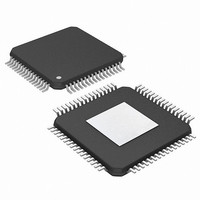PIC24FJ256DA210T-I/BG Microchip Technology, PIC24FJ256DA210T-I/BG Datasheet - Page 36

PIC24FJ256DA210T-I/BG
Manufacturer Part Number
PIC24FJ256DA210T-I/BG
Description
16-bit, 256KB Flash, 96K RAM, USB, Graphics 121 XBGA 10x10x1.20mm T/R
Manufacturer
Microchip Technology
Series
PIC® 24Fr
Specifications of PIC24FJ256DA210T-I/BG
Core Processor
PIC
Core Size
16-Bit
Speed
32MHz
Connectivity
I²C, IrDA, SPI, UART/USART, USB OTG
Peripherals
Brown-out Detect/Reset, GFX, LVD, POR, PWM, WDT
Number Of I /o
84
Program Memory Size
256KB (85.5K x 24)
Program Memory Type
FLASH
Ram Size
96K x 8
Voltage - Supply (vcc/vdd)
2.2 V ~ 3.6 V
Data Converters
A/D 24x10b
Oscillator Type
Internal
Operating Temperature
-40°C ~ 85°C
Package / Case
121-TFBGA
Lead Free Status / RoHS Status
Lead free / RoHS Compliant
Eeprom Size
-
Lead Free Status / RoHS Status
Lead free / RoHS Compliant
Available stocks
Company
Part Number
Manufacturer
Quantity
Price
Company:
Part Number:
PIC24FJ256DA210T-I/BG
Manufacturer:
Microchip Technology
Quantity:
10 000
- Current page: 36 of 408
- Download datasheet (4Mb)
PIC24FJ256DA210 FAMILY
2.6
Many microcontrollers have options for at least two
oscillators: a high-frequency primary oscillator and a
low-frequency
Section 8.0 “Oscillator Configuration” for details).
The oscillator circuit should be placed on the same
side of the board as the device. Place the oscillator
circuit close to the respective oscillator pins with no
more than 0.5 inch (12 mm) between the circuit
components and the pins. The load capacitors should
be placed next to the oscillator itself, on the same side
of the board.
Use a grounded copper pour around the oscillator cir-
cuit to isolate it from surrounding circuits. The
grounded copper pour should be routed directly to the
MCU ground. Do not run any signal traces or power
traces inside the ground pour. Also, if using a two-sided
board, avoid any traces on the other side of the board
where the crystal is placed.
Layout suggestions are shown in Figure 2-4. In-line
packages may be handled with a single-sided layout
that completely encompasses the oscillator pins. With
fine-pitch packages, it is not always possible to com-
pletely surround the pins and components. A suitable
solution is to tie the broken guard sections to a mirrored
ground layer. In all cases, the guard trace(s) must be
returned to ground.
In planning the application’s routing and I/O assign-
ments, ensure that adjacent port pins and other signals
in close proximity to the oscillator are benign (i.e., free
of high frequencies, short rise and fall times and other
similar noise).
For additional information and design guidance on
oscillator circuits, please refer to these Microchip
Application Notes, available at the corporate web site
(www.microchip.com):
• AN826, “Crystal Oscillator Basics and Crystal
• AN849, “Basic PICmicro
• AN943, “Practical PICmicro
• AN949, “Making Your Oscillator Work”
DS39969B-page 36
Selection for rfPIC™ and PICmicro
and Design”
External Oscillator Pins
secondary
®
Oscillator Design”
®
oscillator
Oscillator Analysis
®
Devices”
(refer
to
FIGURE 2-4:
(tied to ground)
Bottom Layer
Copper Pour
Oscillator
Secondary
Primary
Oscillator
Crystal
GND
OSCO
OSCI
C1
C2
Sec Oscillator: C1
DEVICE PINS
(tied to ground)
Single-Sided and In-line Layouts:
Copper Pour
Fine-Pitch (Dual-Sided) Layouts:
`
`
SUGGESTED PLACEMENT
OF THE OSCILLATOR
CIRCUIT
Top Layer Copper Pour
(tied to ground)
2010 Microchip Technology Inc.
`
Primary Oscillator
Sec Oscillator: C2
Crystal
DEVICE PINS
C2
C1
Oscillator
OSCI
OSCO
GND
SOSCO
SOSC I
Crystal
Related parts for PIC24FJ256DA210T-I/BG
Image
Part Number
Description
Manufacturer
Datasheet
Request
R

Part Number:
Description:
Manufacturer:
Microchip Technology Inc.
Datasheet:

Part Number:
Description:
Manufacturer:
Microchip Technology Inc.
Datasheet:

Part Number:
Description:
Manufacturer:
Microchip Technology Inc.
Datasheet:

Part Number:
Description:
Manufacturer:
Microchip Technology Inc.
Datasheet:

Part Number:
Description:
Manufacturer:
Microchip Technology Inc.
Datasheet:

Part Number:
Description:
Manufacturer:
Microchip Technology Inc.
Datasheet:

Part Number:
Description:
Manufacturer:
Microchip Technology Inc.
Datasheet:

Part Number:
Description:
Manufacturer:
Microchip Technology Inc.
Datasheet:











